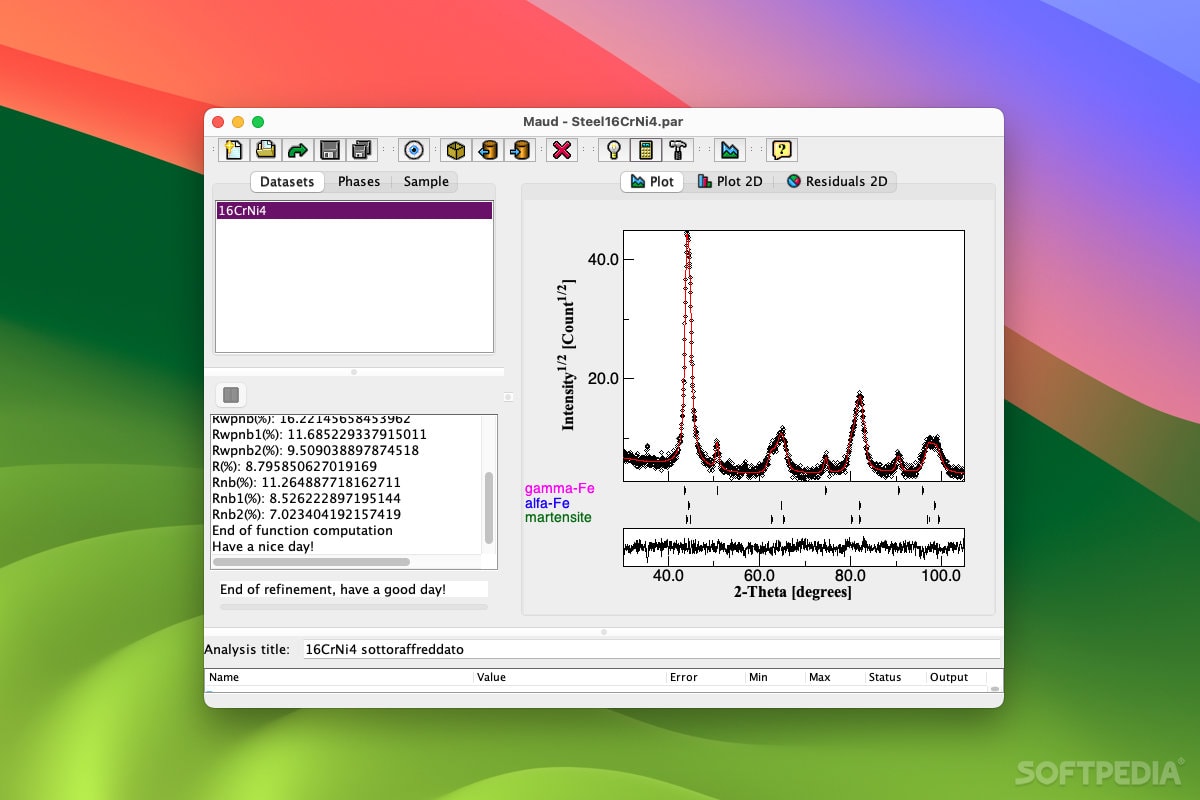
Maud XRD
XRD; Data structure confirmation; XRD data
Description:
In the field of materials science, metallurgy, geology, and crystallography, accurate interpretation of X-ray diffraction (XRD) data is essential for understanding the structural properties of crystalline materials. While traditional XRD analysis provides information on phase identification and lattice parameters, advanced materials often require deeper insights into microstructural features such as crystallite size, microstrain, preferred orientation (texture), and even amorphous content. This is where MAUD (Materials Analysis Using Diffraction) stands out as a highly specialized and powerful software tool for comprehensive XRD analysis using Rietveld refinement and other full-pattern fitting methods.
Developed by Luca Lutterotti and collaborators, MAUD is open-source and built on Java, making it platform-independent (Windows, macOS, Linux). It is designed to handle both conventional laboratory XRD data and synchrotron/neutron diffraction data, and can work with powder diffraction as well as texture and residual stress measurements. With support for a wide range of diffractometers and file formats, MAUD is widely used in academic research, industrial materials development, and synchrotron beamline data analysis.
Core Capabilities and Refinement Features
MAUD uses the Rietveld method, a profile-fitting technique that models the entire diffraction pattern by refining a structural and microstructural model against the observed data. What distinguishes MAUD from other Rietveld refinement tools (like FullProf, GSAS, or TOPAS) is its ability to perform combined analysis, integrating information from multiple diffraction datasets (e.g., XRD, neutron, texture, stress) in a single refinement.
Its capabilities include:
-
Phase identification and quantification
-
Lattice parameter refinement
-
Crystallite size and microstrain analysis
-
Preferred orientation (texture) modeling using pole figures or E-WIMV method
-
Residual stress determination
-
Amorphous phase quantification
-
Structureless fitting and Pawley refinement options
-
Combined refinement from multiple detectors or beamlines
MAUD supports data from Bruker, PANalytical, Rigaku, and synchrotron formats like .xye or .chi, and allows users to import CIF files for crystal structures directly.
Applications in Research and Materials Science
MAUD is particularly useful in:
-
Nanomaterials research, where accurate estimation of crystallite size and strain is critical for performance evaluation.
-
Additive manufacturing and metallurgy, for analyzing residual stresses and texture in printed or rolled materials.
-
Ceramics and thin films, for quantifying multiphase systems and assessing orientation effects.
-
Geology and mineralogy, for modeling complex mixtures and fine-grained or partially amorphous materials.
-
Battery and catalyst materials, to study phase evolution, solid-solution behavior, and lattice distortion during cycling.
For researchers investigating SbSI nanowires, graphene-based composites, or transition metal oxides, MAUD enables in-depth understanding of how synthesis or processing affects structural integrity and material performance.
Advanced Modeling and Combined Analysis
MAUD’s most advanced feature is combined analysis, where multiple datasets (e.g., from different geometries, beam energies, or techniques) are refined simultaneously to improve model accuracy. This is particularly useful in synchrotron experiments or multi-technique characterization campaigns.
Other high-level capabilities include:
-
Texture fitting using the E-WIMV or arbitrarily defined orientation distribution functions (ODFs)
-
Stress analysis using lattice strain vs. orientation data
-
Constraints and restraints for fixing or limiting parameter values during refinement
-
Custom scripting and plug-in extensions, allowing users to automate batch refinements or build custom models
Visualization tools in MAUD allow users to monitor fit quality, plot residuals, display pole figures, and inspect refined parameters interactively.
Challenges and User Considerations
While MAUD is extremely powerful, it has a steep learning curve, especially for users new to Rietveld refinement or combined analysis. The graphical interface is functional but less intuitive than more commercial packages. However, with the available tutorials, user manuals, and community forums, many researchers successfully incorporate MAUD into their workflow.
Best practices include:
-
Preparing accurate CIF input files for each phase
-
Calibrating instrument parameters (zero shift, FWHM, shape) before full refinement
-
Performing stepwise refinement: start with scale and lattice parameters, then texture, then microstructure
Conclusion
MAUD is a highly advanced, open-source platform for comprehensive X-ray diffraction analysis that extends beyond simple phase identification to deliver rich insights into texture, stress, and microstructure. It is especially well-suited for researchers working with complex or multiphase materials, nanostructures, and advanced functional systems. While it requires some learning and experience, MAUD offers exceptional analytical depth and flexibility, making it a powerful tool in the modern crystallographer’s or materials scientist’s toolkit.